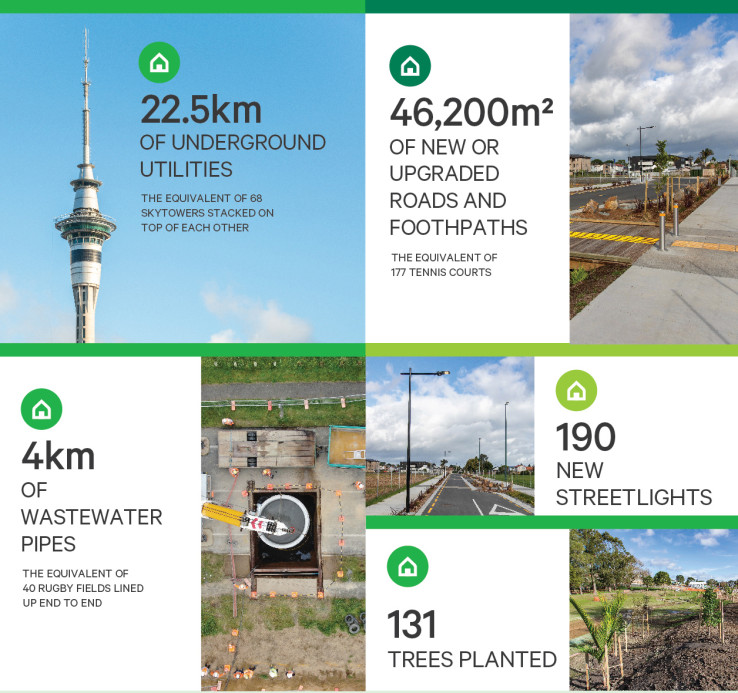Kāinga Ora urban development keeps on delivering
25 October 2024
New roads, pipes and streetlights have paved the way for thousands of new homes in neighbourhoods across Auckland and in eastern Porirua, as large-scale urban developments led by Kāinga Ora hit new milestones.
In the 12 months to 30 June 2024, Kāinga Ora and its delivery alliance partners, Te Aranga and LEAD, delivered over 46,200m2 of new or upgraded roads and footpaths, removed power poles by undergrounding over 22.5km of utility lines and lit the way with over 190 streetlights.
Using publicly-owned and strategically-acquired land, Kāinga Ora urban development teams plan, co-ordinate, integrate and deliver the infrastructure needed to enable a greater number of social and private homes, as well as safeguarding neighbourhoods from severe weather events and delivering popular public amenity.
Kāinga Ora is driving a housing density shift in suburban communities that would not otherwise have benefited from investment, and the scale Kāinga Ora is working at means it’s possible to address multiple infrastructure deficit issues in the same location, at the same time.
Kāinga Ora Director - Development, Tamsyn McDonald, says the work is extensive, it can take years to complete and credits the progress to date to the successful partnerships between public and private organisations, plus intentional engagement with communities.
“Brownfield development – that is development of land that has previously been developed - is complex and requires collaboration between a large number of parties,” she says.
“Over the last few years, we’ve worked to build strong relationships with the community and our partners to ensure we are delivering what is needed for future growth more efficiently, while keeping disruption to a minimum.
“Of course, infrastructure delivery is not just about the essential pipes and utilities, it can also make neighbourhoods great places to live, by restoring wetlands and providing great public spaces for people to spend time.”

Integral to the urban infrastructure being delivered is a focus on improving the quality and resilience of the neighbourhoods.
“The increasing frequency and intensity of climate events is an issue we cannot ignore,” Tamsyn says.
“Kāinga Ora has embedded climate resilience, notably flood prevention, into its urban masterplanning to ensure every home built is protected, as well as the people who live there.”
In the eastern Porirua large-scale development Te Rā Nui, almost 100 new street trees and 300m2 of native plants have been planted over the last financial year. Kāinga Ora, one of the project partners and its civils and infrastructure experts, Te Aranga, have also installed four raingardens and one pocket park into the area for the residents to enjoy while simultaneously supporting the local ecology.
Across this development and the large-scale developments in Auckland, a total of almost 7km of new mains are now connecting homes with fresh water, and 4km of wastewater pipes are helping see to its safe removal. Homes and businesses will also be better protected from severe weather events, with almost 3.5km of stormwater network upgrades completed.
“We’re making real progress across all of our large-scale projects,” says Tamsyn.
“This last financial year we celebrated the completion of all civil and infrastructure works in both our Roskill South and Northcote developments, enabling more than 2,600 new homes to be built across the two suburbs.
“A huge amount of work has been completed but we are not resting on our laurels, there is still a lot more to do across all our large-scale projects. We continue to improve our efficiency, getting through the work faster, all while ensuring we remain focused on creating long-term economic and social value for these neighbourhoods today, and well into the future.”
By the numbers
FY23/24 delivery highlights for Te Rā Nui development in eastern Porirua:
- Almost 14,000m2 of new or upgraded roads and footpaths
- Two raingardens and one pocket park delivered
- Over 2.5km of wastewater pipes upgraded
- 150m2 of native plants and 94 trees planted
- 23 new streetlights installed
FY23/24 delivery highlights across Kāinga Ora Auckland large-scale projects:
- More than 14,200m2 of new or upgraded roads and 18,000m2 of widened foothpaths delivered
- 22km of new utility lines undergrounded
- 7km of new watermains and 1.5km wastewater pipes installed
- 3.5km of stormwater network improvements
- 170 new streetlights installed
- 906m2 of native plants and 37 trees planted
